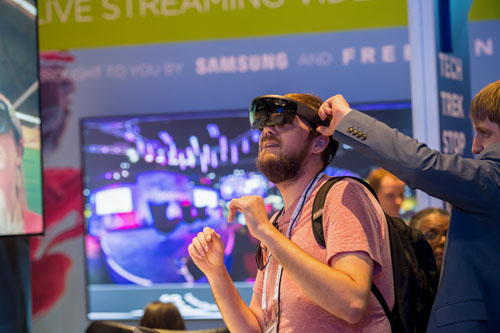Nelson-Atkins Museum of Art is Looking at Visualization Technology to Create the Museum of the Future
By Tim Kridel, Special to AVIXA
 The Nelson-Atkins Museum of Art in Kansas City, Mo., has more than 35,000 works of art and welcomes 500,000 visitors a year. Like many museums, it’s exploring ways to use virtual and augmented reality, and many of the lessons learned so far are applicable to other types of businesses. Many museums use AR as a way to engage visitors and enhance their experience, and use VR as a tool for engaging them at home, with the goal of encouraging them to visit.
The Nelson-Atkins Museum of Art in Kansas City, Mo., has more than 35,000 works of art and welcomes 500,000 visitors a year. Like many museums, it’s exploring ways to use virtual and augmented reality, and many of the lessons learned so far are applicable to other types of businesses. Many museums use AR as a way to engage visitors and enhance their experience, and use VR as a tool for engaging them at home, with the goal of encouraging them to visit.
A few years ago, a donor gave Nelson-Atkins an extensive collection of impressionist paintings. The museum first had to build a gallery, which opened this year. In the interim, the museum created a VR recording of the collection in the donor’s home so people could get a preview. This kind of virtual showcasing can be useful for encouraging people to visit a museum or become a patron, both of which provides ROI by driving revenue.
Visualization can also be used to put people in places where they literally can’t fit. Nelson-Atkins has a collection of miniature angels carved out of ivory. It’s working with a local hospital to CAT scan the angels so those visuals can be converted to 360-degree immersive video. “They’ll be able to explore that in a completely different way than they would in reality,” says Doug Allen, the museum’s CIO. A business could use a similar approach to enable employees to better understand a small, intricate piece of machinery. Or a hospital could use it to help a patient better understand an upcoming procedure, such as a valve replacement or bypass.
For documentation purposes, Nelson-Atkins also is now recording 360-degree videos every time it renovates a gallery or sets up an exhibition. “It’s standard to photograph an exhibition, but [now] we’re also going to be taking 360-degree video,” says Allen. “So [the technology] has taken on this additional function of documentation that makes it easier. Let’s say 10 years from now, somebody wants to look back on how we had it set up, we’ll be able to put on the headset and be more immersive to understand it.”
Making Plans for More Visualization Applications
The Nelson-Atkins Museum would like to use visualization for touring spaces before they open. With a recent gallery reconstruction, “all of the CAD drawings were done in a tool that allowed for 3D rendering,” Allen says. “I told the architectural firm: ‘We’ve got an Oculus Rift. We’d love to be able to show people the finished galleries before we put a nail into the walls.’” Unfortunately, due to the amount of time needed to have images rendered, the museum and the firm have not quite made this happen yet, but are hopeful it will happen.
When that becomes practical, it would help avoid problems such as expensive change orders. “There are all sorts of reasons why it would be great for people to be able to put on the headset and be in the exhibition,” Allen says. “They’re trying to decide whether these objects are too close to one another. Looking at it on a flat, 2D CAD drawing is not useful. There are too many times where we finally have the place built out, and people see things hanging next to one another on the wall, and they say: ‘The label is too close’ or ‘We’ve got to put those [farther] apart.’ I think all of that we could solve in the virtual environment.”
Nelson-Atkins is also exploring further how it can use AR. One concern — shared by other museums — is that visitors will spend more time looking at their smartphone than at the art. But those concerns may be outweighed by AR’s benefits, such as engaging younger demographics in ways that encourage them to come back. Allen cites the example of the Detroit Institute of Arts, which is using Google’s Tango platform.
“They have really great navigation,” Allen says. “You’ll see blue dots along the floor telling you to turn. When you come up to the mummy, you hold up the phone and see inside the casket. When you walk around the casket, it knows where you are at each point and orients you properly.”
Other verticals could adopt and adapt this use case. For example, a large campus — whether it’s a company or a college — could use this kind of AR setup to help people find their way around and get information about what’s inside buildings instead of inside mummies. The business case could center around savings from requiring fewer or no employees to help people find their way around and get information. In fact, many businesses and colleges already use wayfinding digital signage for exactly that reason.
To transform these and other applications into reality, Allen would like to see the cost of content creation tools and services come down while their selection grows. “You’re pretty much one-offing because there are no good tools to do that kind of stuff,” he says. “It’s expensive. You have to hire contractors.”
Allen also would like to see VR evolve away from PC-on-a-cart systems and expensive headsets, and more toward something that visitors can just pick up when they enter or bring in because they already own it. “That’s something I think is going to really leap forward the use of VR: an inexpensive headset,” he says.





